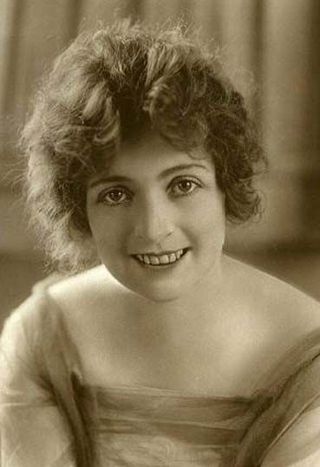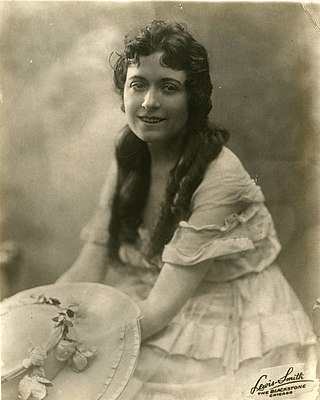
Florence Lawrence was a Canadian-American stage performer and film actress. She is often referred to as the "first movie star", and was long thought to be the first film actor to be named publicly until evidence published in 2019 indicated that the first named film star was French actor Max Linder. At the height of her fame in the 1910s, she was known as the "Biograph Girl" for work as one of the leading ladies in silent films from the Biograph Company. She appeared in almost 300 films for various motion picture companies throughout her career.

James Oliver Curwood was an American action-adventure writer and conservationist. His books were often based on adventures set in the Hudson Bay area, the Yukon or Alaska and ranked among the top-ten best sellers in the United States in the early and mid 1920s, according to Publishers Weekly. At least one hundred and eighty motion pictures have been based on or directly inspired by his novels and short stories; one was produced in three versions from 1919 to 1953. At the time of his death, Curwood was the highest paid author in the world.

Myrtle Gonzalez was an American actress. She starred in at least 78 silent era motion pictures from 1913 to 1917, of which 66 were one and two-reel shorts.

Laurence Norwood Trimble was an American silent film director, writer and actor. Trimble began his film career directing Jean, the Vitagraph Dog, the first canine to have a leading role in motion pictures. He made his acting debut in the 1910 silent Saved by the Flag, directed scores of films for Vitagraph and other studios, and became head of production for Florence Turner's independent film company in England (1913–1916). Trimble was most widely known for his four films starring Strongheart, a German Shepherd dog he discovered and trained that became the first major canine film star. After he left filmmaking he trained animals exclusively, particularly guide dogs for the blind.

Carlyle Blackwell was an American silent film actor, director and producer.

Florence Vidor was an American silent film actress.

Enid Eulalie Bennett was an Australian silent film actress, mostly active in American film.

The Courage of Marge O'Doone is a 1920 American silent drama film directed by David Smith and featuring Pauline Starke, Billie Bennett, Niles Welch and Boris Karloff. It was written by Robert N. Bradbury, based on the novel by James Oliver Curwood. The film is considered to be lost.

Stolen Life is a 1939 British drama film directed by Paul Czinner and starring Michael Redgrave, Elisabeth Bergner and Wilfrid Lawson.

Erna Morena was a German film actress, film producer, and screenwriter of the silent era. She appeared in 104 films between 1913 and 1951.

The Return of Draw Egan is a 1916 American silent Western film starring William S. Hart, Louise Glaum, Margery Wilson, Robert McKim, and J.P. Lockney.

Zena Virginia Keefe was an American actress in silent film, active in the 1910s and 1920s.

Rollin Summers Sturgeon was an American film director of silent films active from 1910 to 1924. He directed 101 films during this period.

St. Elmo is a 1914 American silent drama film produced by the Balboa Amusement Producing Company and distributed by William Fox's Box Office Attractions Company. It was the first feature-length film adaptation of Augusta Jane Evans's 1866 novel of the same name. The story follows the life of the title character, who kills his cousin over the love of Agnes, falls from grace, and eventually finds redemption and love with Edna. It is disputed who directed the film; many sources credit Bertram Bracken, while others list St. Elmo as J. Gordon Edwards's directorial debut.

Uncle Tom's Cabin is a 1910 American silent short drama produced by the Thanhouser Company. The film was adapted by from the 1852 novel Uncle Tom's Cabin by Harriet Beecher Stowe. The plot of the Thanhouser production streamlined the actual story to portray the film over the course of a single reel. The film was released on July 26, 1910, on the same day that Vitagraph released the first reel of their own three reel version of Uncle Tom's Cabin. This prompted the Thanhouser Company to advertise against the Vitagraph film by referring to the other as being overly drawn out. The film garnered mixed, but mostly positive reception in trade publications. The film is presumed lost.

Louise Lagrange was a French film actress.

William Pitt Striker Earle was an American director of the silent film era. He attended Columbia University and worked for a time as a photographer before breaking into the movie business by sneaking onto the lot of Vitagraph Company of America to observe how directors worked. After a few days of this, Earle approached the studio president and was given his first movie to direct, For the Honor of the Crew, a short about a crew race at Columbia University. He subsequently directed a number of features and shorts for Vitagraph. Later he worked with producer David O. Selznick. Earle founded his own, short-lived production company called Amex Production Corporation with J. S. Joffe, and shot the final two films of his career in Mexico.

Mary Charleson was an Irish silent film actress who starred in about 80 films in the U.S. between 1912 and 1920.

The Wheels of Justice is a 1915 American silent film written by Edward J. Montagne, directed by Theodore Marston, and starring Dorothy Kelly, James Morrison and Louise Beaudet. It premiered in February 1915, before its wide release in August of the same year. It was met with mostly positive reviews.

George Kunkel was an American character actor and operatic baritone.





















